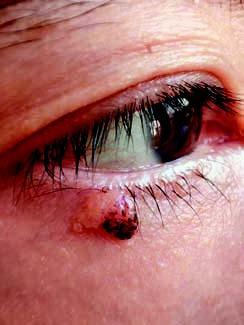Squamous cell papilloma of the eyelid is the most common benign epithelial tumor of the eyelid. It can occur at any age, with incidence increasing with age, and shows no difference in prevalence across genders or ethnicities. It is characterized by papillomatous growth and squamous epithelial cell hyperplasia. The condition is thought to be associated with viral infections, although inflammation, environmental factors, ultraviolet radiation, and hypersensitivity reactions may also contribute to its development.

Figure 1 External appearance of a squamous cell papilloma of the right eyelid
The patient exhibits a squamous cell papilloma on the right lower eyelid. The lesion demonstrates lobulated growth with surface pigmentation.
The lesions most commonly occur at the eyelid margin and exhibit slow progression. Clinical presentations are varied, and the lesions may be solitary or multiple. They can be either pigmented or similar in color to the surrounding skin, pedunculated or sessile, and vary in size. The growth typically has a papillomatous appearance, with a rough surface and a prickly texture upon palpation. The tumors are soft and brittle in consistency and may show keratinization and increased pigmentation.